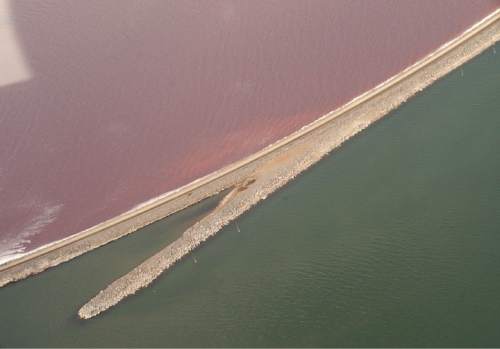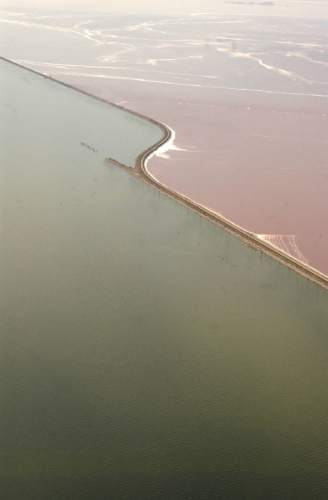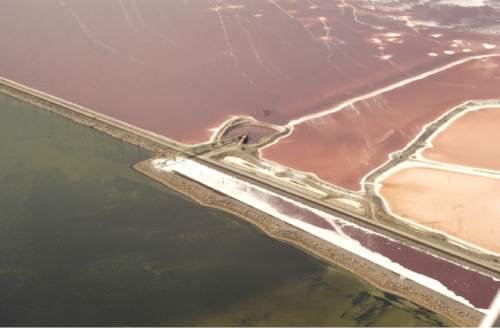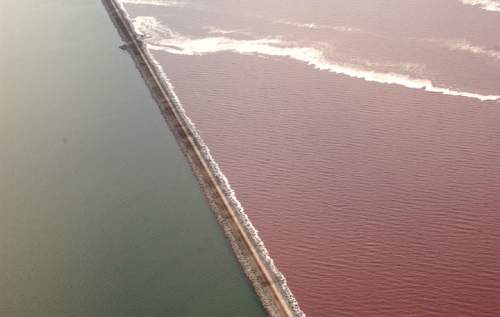This is an archived article that was published on sltrib.com in 2016, and information in the article may be outdated. It is provided only for personal research purposes and may not be reprinted.
Antelope Island • As water levels on the Great Salt Lake continue to slide, a proposal to delay breaching the Union Pacific causeway is gaining steam.
The causeway, which bisects the lake, limits the flow of water between the north and south sections of the lake. Culverts in the causeway were intended to facilitate the flow of water between the two lake halves, but by 2011 they had sunk about 20 feet and become unstable, leading Union Pacific to begin filling them. Union Pacific agreed to open a breach, traversed by a bridge, elsewhere on the causeway to replace the culverts.
Union Pacific's construction schedule would have the breach opened sometime this fall, likely this month or October, said Justin Jacobs, a spokesman for the railroad. But industry groups, environmental advocates and state officials all agree that timing would have negative consequences for the lake and its ecosystem.
Jacobs said the company, which is in talks regarding the project with the Utah Division of Forestry, Fire and State Lands, is looking at postponing the breach and will most likely agree to the delay, though no specific timeline has been established.
The primary concern — at least in the sense of the immediate future — is the change in salinity that will accompany the opening of the breach. The north side of the lake receives a much smaller amount of fresh water than the south side and consequently has a higher concentration of salt. When the breach allows the two halves to intermingle again, experts on all sides of the issue anticipate the south side of the lake will see an increase in salinity.
The timing of the breach is essential, said Don Leonard, CEO of the Great Salt Lake Brine Shrimp Cooperative. While brine shrimp are renowned for their ability to thrive in saline environments, he said, there is a limit to how much salt they can tolerate — and the south arm of the Great Salt Lake, where his company collects the majority of its brine shrimp, is already nearing that limit.
The brine shrimp are especially sensitive when they're young, Leonard said, so if the breach is opened this fall, the sudden increase in salinity could result in fewer brine shrimp reaching their adult stage before the coming winter.
At last week's meeting of the Great Salt Lake Advisory Council, Leonard said the state has already cut the brine shrimp harvest short for the past three years to ensure there are enough brine shrimp in the ecosystem to feed the migratory birds that stop at the Great Salt Lake.
In two of those three years, Leonard said, the GSL Brine Shrimp Cooperative brought in below-average harvest. This year, he said, isn't looking good either.
In the past, Leonard said, his company has advocated for opening the causeway to improve the flow of salt from one side of the lake to the other. But right now, he said, the timing is wrong.
"In the Great Salt Lake, you have to take both the long-term and short-term view," he said. "Sometimes the short term gets so potentially devastating that you have to make critical decisions."
The culprit behind the current situation, Leonard said, is the low lake level.
As of Monday afternoon, the south arm of the Great Salt Lake was sitting at an elevation of 4,192.8 feet, just above last year's record low of 4,192.7 feet, according to the U.S. Geological Survey. The north arm, which is typically lower in elevation, sits at 4,189.2, already below last year's record of 4,191.
The low levels concentrate the salt already present in the lake, Leonard said. Consequently, small changes in the amount of actual salt in the lake — such as the influx of salt from the north arm into the south arm — have greater impact on the overall system than if there were more water available to dilute the salt.
The breach is also likely to equalize the distribution of water. While the drier north arm is expected to rise by about 1.5 feet, the south arm is expected to drop by a roughly equal amount. This possibility has raised concern among interests on the south side, including the majority of lake's mineral extraction companies, and the Great Salt Lake Yacht Club, which operates out of the state-run Great Salt Lake Marina.
Janet Robins, the Great Salt Lake Yacht Club's commodore, said the deepest point of the marina is currently about 5 feet deep, and water depth at the mouth of the marina is just 3.3 feet. If the lake's level falls any further, she said, the rescue boats that serve the entire Great Salt Lake in the event of emergencies could end up trapped inside the marina.
Most recreational boats have already been pulled out of the marina, Robins said. Only 30 to 40 boats remain, she said, because those boats are small enough to manage the shallow water — and because the marina has run out of room in the parking lot, which has become the temporary holding site for boats too large to remain in the water.
This is the second year in a row that water levels at the marina have been insufficient for most boating, Robins said.
"People are so discouraged they're taking their boats out of state," she said.
That doesn't mean the rescue boats won't be needed, Robins said — those search and rescue teams are dispatched 110 times per year on average, and may be responding to anything from a sailboat getting stuck on a reef to lost duck hunters in the wetlands or even downed aircraft.
Because of the large number of airports located near the lake — Salt Lake City International as well as multiple smaller airports and several associated with military operations — plane-related incidents are common on the lake, Robins said.
In the long term, Robins said, other issues will need to be addressed to keep the marina viable.
The state needs a better paradigm for managing water use, she said, and the marina, which is suffering not only because of the low lake levels but also because it has filled in with silt, needs to be dredged. But in the short term, she said, if the breach can wait until, say, December, when winter precipitation can begin to bring the lake back up again, the state may be able to avert that disaster.
"Many of us do agree that there are benefits to connecting the two sides of the lake, mainly protecting the wildlife and breeding grounds," she said. "But maybe a slower opening of the two sides could lessen the environmental impact."
Twitter: @EmaPen











